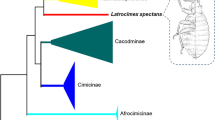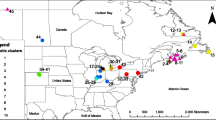Abstract
The bedbug, Cimex lectularius, is a well-known human ectoparasite that is reemerging after a long absence of several decades in developed countries of North America and Western Europe. Bedbugs’ original hosts were likely bats, and the bedbugs are still common in their roosts. Using morphometry and sequences of mitochondrial cytochrome oxidase subunit I and 16S genes, we showed that the populations on bats and humans are largely isolated and differ in morphology. The character of the morphological difference suggests it to be due to adaptation to different hosts, namely adaptations to different sensory, feeding, and dispersal needs. Using the molecular data, we estimated the time of splitting into bat- and human-parasitizing groups using the isolation-with-migration model. The estimate is surprisingly long ago and seems to predate the expansion of modern human from Africa. The gene flow between bat- and human-parasitizing bedbugs is limited and asymmetric with prevailing direction from human-parasitizing populations to bat-parasitizing populations. The differentiation of the populations fits the concept of host races and supports the idea of sympatric speciation. Furthermore, our findings contradict recently formulated hypotheses suggesting bat roosts as a source of bedbug’s resurgence as a human pest. Also, we extend the known host range of the bedbug by two bat species.





Similar content being viewed by others
References
Abul-Hab J (1979) On the bed bugs (Hemiptera, Cimicidae) in Iraq. Iraq Bull End Dis 19(1–4):65–76
Als TD, Nash DR, Boomsma JJ (2002) Geographical variation in host-ant specificity of the parasitic butterfly Maculinea alcon in Denmark. Ecol Entomol 27(4):403–414
Armitage SJ, Jasim SA, Marks AE, Parker AG, Usik VI, Uerpmann HP (2011) The southern route “out of Africa”: evidence for an early expansion of modern humans into Arabia. Science 331:453–456
Aulagnier S, Haffner P, Mitchell-Jones AJ, Moutou F, Zima J (2008) Mammals of Europe, North Africa and the Middle East. Delachaux & Niestlé, Paris
Bandelt HJ, Forster P, Rohl A (1999) Median-joining networks for inferring intraspecific phylogenies. Mol Biol Evol 16(1):37–48
Bartonička T (2008) Cimex pipistrelli (Heteroptera, Cimicidae) and the dispersal propensity of bats: an experimental study. Parasitol Res 104:163–168
Bartonička T, Gaisler J (2007) Seasonal dynamics in the number of parasitic bugs (Heteroptera, Cimicidae): a possible cause of roost switching in bats (Chiroptera: Vespertilionidae). Parasitol Res 100:1323–1330
Berrilli F, D’Amelio S, Rossi L (2002) Ribosomal and mitochondrial DNA sequence variation in Sarcoptes mites from different hosts and geographical regions. Parasitol Res 88(8):772–777
Bobkova O (2001) Ectoparasitic fauna of migrant and residental bat species. Novitates Theriologicae 6:81–84
Bogdanowitz W (1994) Myotis daubentonii. Mammal Species 475:1–9
Brower AVZ (1994) Rapid morphological radiation and convergence among races of the butterfly Heliconius erato inferred from patterns of mitochondrial DNA evolution. PNAS 91:6491–6495
Coyne JA, Orr HA (2004) Speciation. Sinauer Associates, Sunderland
Derricourt R (2006) Getting “out of Africa”: sea crossings, land crossings and culture in the hominin migrations. J World Prehist 19:119–132
Dick CW, Esberard CEL, Graciolli G, Bergallo HG, Gettinger D (2009) Assessing host specificity of obligate ectoparasites in the absence of dispersal barriers. Parasitol Res 105(5):1345–1349
Doggett SL, Geary MJ, Russell RC (2004) The resurgence of bed bugs in Australia: with notes on their ecology and control. Environ Health 4(2):30–38
Dres M, Mallet J (2002) Host races in plant-feeding insects and their importance in sympatric speciation. Phil Trans R Soc B 357(1420):471–492
Dubinij VB (1947) Ekologičeskije nabljudjenija nad krovososuščimi klopami sem. Cimicidae Daurskoj stepi. [Ecological remarks to bloodsucking bugs of the family Cimicidae of Daur steppe] (in Russian). Entomologičeskoje obozrenije 39(3–4):232–246
Eichler W (1937) Über die bei europäischer Vögeln vorkommenden Wanzenarten. Zool Anz 120(11–12):267–271
Excoffier L, Laval G, Schneider S (2005) Arlequin ver. 3.0: an integrated software package for population genetics data analysis. Evol Bioinform Online 1:47–50
Farris JS, Kallersjo M, Kluge AG, Bult C (1995) Testing significance of incongruence. Cladistics 10:315–319
Feroz M (1969) Toxicological and genetical studies of organophosphorus-resistance in Cimex lectularius L. Bull Entomol Res 59(1968):377–382
Full RJ, Tu MS (1990) Mechanics of a rapid running insect: two-, four- and six-legged locomotion. J Exp Biol 156:215–231
Hafner MS, Sudman PD, Villablanca FX, Spradling TA, Demastes JD, Nadler SA (1994) Disparate rates of molecular evolution in cospeciating hosts and parasites. Science 265:1087–1090
Hajibabaei M, Janzen DH, Burns JM, Hallwachs W, Hebert PDN (2006) DNA barcodes distinguish species of tropical Lepidoptera. PNAS 103(4):968–971
Hey J, Nielsen R (2004) Multilocus methods for estimating population sizes, migration rates and divergence time, with applications to the divergence of Drosophila pseudoobscura and D. persimilis. Genetics 167:747–760
Hey J, Nielsen R (2007) Integration within the Felsenstein equation for improved Markov chain Monte Carlo methods in population genetics. PNAS 104:2785–2790
Horáček I (1983–4) Remarks on the causality of population decline in European bats. Myotis 21–22:138–147
Horváth G (1913) La distribution géographique des cimicides et l´origine des punaises des lits. Extrait du IXe Congres International de Zoologie Tenu a Monaco, pp 294–299
Huson DH, Rupp R, Scornavacca C (2010) Phylogenetic networks. Cambridge, Cambridge
Hwang SW, Svoboda TJ, De Yong IJ, Kabasele KJ, Gogosis E (2005) Bed bug infestation in an urban environment. Emerg Infect Dis 11(4):533–538
Jackson DA (1993) Stopping rules in principal component analysis: a comparison of statistical and heuristic approaches. Ecology 74(8):2204–2214
Johnson CG (1939) Taxonomic characters, variability, and relative growth in Cimex lectularius L. and C. columbarius Jenyns (Heteropt. Cimicidae). Trans R Entomol Soc Lond 89(2):543–568
Johnson CG (1941) The ecology of the bed-bug, Cimex lectularius L., in Britain. J Hyg 41(4):345–361
Johnson KP, Cruickshank RH, Adams RJ, Smith VS, Page RDM, Clayton DH (2003) Dramatically elevated rate of mitochondrial substitution in lice (Insecta: Phthiraptera). Mol Phyl Evol 26:231–242
Kambhampati S, Smith PT (1995) PCR primers for the amplification of four insect mitochondrial gene fragments. Insect Mol Biol 4:223–236
Katoh K, Asimenos G, Toh H (2009) Multiple alignment of DNA sequences with MAFFT methods. Mol Biol 537:39–64
Kilpinen O, Kristensen M, Jensen KMV (2011) Resistance differences between chlorpyrifos and synthetic pyrethroids in Cimex lectularius population from Denmark. Parasitol Res 109(5):1461–1464
Krasnov BR, Korine C, Burdelova NV, Khokhlova IS, Pinshow B (2007) Between-host phylogenetic distance and feeding efficiency in hematophagous ectoparasites: rodent fleas and a bat host. Parasitol Res 101(2):365–371
Kuhner MK (2008) Coalescent genealogy samplers: windows into population history. Trends Ecol Evol 24:86–93
Langmore NE, Maurer G, Adcock GJ, Kilner RM (2008) Socially acquired host-specific mimicry and the evolution of host races in Horsfield’s bronze-cuckoo Chalcites basalis. Evolution 62(7):1689–1699
Lanza B (1999) I parassiti dei pipistrelli (Mammalia, Chiroptera) della fauna italiana. Monographie 30. Museo Regionale di Scienze Naturali, Turin
Light JE, Reed DL (2008) Multigene analysis of phylogenetic relationships and divergence times of primate sucking lice (Phthiraptera: Anoplura). Mol Phyl Evol 50:376–390
Lýsek H (1966) Neobvyklé způsoby šíření Cimex lectularius. [Unusual ways of dispersal of Cimex lectularius] (in Czech). Československá. Hygiena 11(10):617–620
Marchetti K, Nakamura H, Gibbs HL (1998) Host-race formation in the common cuckoo. Science 282(5388):471–472
McCoy KD, Tirard C, Michalakis Y (2003) Spatial genetic structure of the ectoparasite Ixodes uriae within breeding cliffs of its colonial seabird host. Heredity 91:422–429
Nielsen R, Beaumont MA (2009) Statistical inferences in phylogeography. Mol Eco 18:1034–1047
Nielsen R, Wakeley J (2001) Distinguishing migration from isolation. A Markov chain Monte Carlo approach. Genetics 158:885–896
Poppius B (1912) Cimex verspertilionis n.sp. Acta Soc Fauna Flora Fenn 38:56–58
Povolný D (1957) Kritická studie o štěnicovitých (Het. Cimicidae) v Československu. [Review study on cimicids (Het. Cimicidae) in Czechoslovakia] (in Czech). Folia Zool 6 (10) (1):59–80
Povolný D (1959) Rozšíření a původ štěnice obecné. [Distribution and origin of the bed bug] (in Czech). Živa 1959 (45):225–226
Povolný D, Usinger RL (1966) The discovery of a possibly aboriginal population of the bed bug (Cimex lectularius Linnaeus, 1958). Acta Mus Moraviae, Sci biol 51:237–242
Protić L, Paunović M (2006) Bat bugs Cimex dissimilis (Horváth, 1910) (Heteroptera: Cimicidae)—the first record from Serbia. In: Abstracts, 3rd meeting of International Heteropterological Society, Wageningen, Netherlands
Reed DL, Smith VS, Hammond SL, Rogers AL, Clayton DH (2004) Genetic analysis of lice supports direct contact between modern and archaic humans. PLOS Biology 2(11):1973–1983
Reinhardt K, Siva-Jothy MT (2007) Biology of the bed bugs (Cimicidae). Annu Rev Entomol 52:351–374
Reinhardt K, Harder A, Holland S, Hooper J, Leake-Lyall C (2008) Who knows the bed bug? Knowledge of adult bed bug appearance increases with people age in three counties of Great Britain. J Med Entomol 45(5):956–958
Romero A, Potter MF, Haynes KF (2007) Insecticide resistance in the bedbugs: a factor in the pest sudden resurgence? J Med Entomol 44(2):175–178
Rybin N, Horáček I, Červený J (1989) Bats of southern Kirghizia: distribution and faunal status. In: Hanák V, Horáček I, Gaisler J (eds) European bat research 1987. Charles University Press, Prague, pp 421–441
Sailer R (1952) The bedbug. An old bedfellow that´s still with us. Pest control 10 (20):22, 24, 70, 72
Shea JJ (2008) Transitions or turnovers? Climatically-forced extinctions of Homo sapiens and Neanderthals in the east Mediterranean Levant. Quaternary Sci Rev 27:2253–2270
Simon C, Frati F, Beckenbach A, Crespi B, Liu H, Flook P (1994) Evolution, weighting and phylogenetic utility of mitochondrial gene sequences and a compilation of conserved polymerase chain reaction primers. Ann Entomol Soc Am 87(6):651–701
Simov N, Ivanova T, Schunger I (2006) Bat-parasitic Cimex species (Hemiptera: Cimicidae) on the Balkan Peninsula, with zoogeographical remarks on Cimex lectularius, Linnaeus. Zootaxa 2006(1190):59–68
Slack HD (1937) Notes on Scottish Hemiptera–Heteroptera. Scottish Naturalist 225(91)
StatSoft I (2007) STATISTICA (data analysis software system), version 8.0. www.statsoft.com. Accessed 01 Dec 2009
Swofford DL (1999) PAUP* Phylogenetic analysis using parsimony; version 4. Sinauer Associates, Sunderland
Szalanski AL, Austin JW, McKern JA, Steelman CD, Gold RE (2008) Mitochondrial and ribosomal internal transcribed spacer 1 diversity of Cimex lectularius (Hemiptera: Cimicidae). J Med Entomol 45(2):229–236
Ting L, Blickhan R, Full RJ (1994) Dynamic and static stability in hexapedal runners. J Exp Biol 197:251–269
Ueshima N (1964) Experiments on reproductive isolation in Cimex lectularius and Cimex columbarius (Hemiptera: Cimicidae). Pan-Pac Entomol 40(1):47–53
Usinger RL (1966) Monograph of Cimicidae. Entomological Society of America, Washington, D.C
Wagner E (1967) Wanzen oder Heteropteren II. Cimicomorpha, vol 55. Die Tierwelt Deutschlands und der angrenzenden Meeresteile. Gustav Fischer, Jena
Walter G (2004) Űberblick zum Vorkommen und zur Biologie von Ectoparasiten (Siphonaptera; Cimicidae; Nycteribiidae; Calliphoridae) bei Fledermäusen in Deutschland. Nyctalus 9(5):460–476
Weidner H (1958) Die Entstehung der Hausinsekten. Z Angew Entomol 42:429–447
Zhu F, Wigginton J, Romero A, Moore A, Ferguson K, Palli R, Potter MF, Haynes KF, Palli SR (2010) Widespread distribution of knockdown resistance mutations in the bed bug, Cimex lectularius (Hemiptera: Cimicidae), populations in the United States. Arch Insect Biochem 73(4):245–257
Acknowledgments
Unfortunately, we cannot name all the far more than 100 people who have taken part in collecting bedbug material for the study. We express our deepest thanks to all of them! We are thankful for help with lab work and comments on the manuscript from Josef Bryja, Jan Zima (Academy of Sciences, Czech Republic), Petr Janšta, Jakub Straka (Charles University, Czech Republic), and Martina Komárková (Institute of Animal Science, Prague, Czech Republic). We would like to express our gratitude to Gale Allen Kirking (English Editorial Services, Brno) for the correction of English. The study was supported by the Ministry of Education, Youth and Sports of the Czech Republic (project no. MSM 0021620828) and a grant from the Grant Agency of Charles University (no. 2010/45610).
Author information
Authors and Affiliations
Corresponding author
Rights and permissions
About this article
Cite this article
Balvín, O., Munclinger, P., Kratochvíl, L. et al. Mitochondrial DNA and morphology show independent evolutionary histories of bedbug Cimex lectularius (Heteroptera: Cimicidae) on bats and humans. Parasitol Res 111, 457–469 (2012). https://doi.org/10.1007/s00436-012-2862-5
Received:
Accepted:
Published:
Issue Date:
DOI: https://doi.org/10.1007/s00436-012-2862-5




